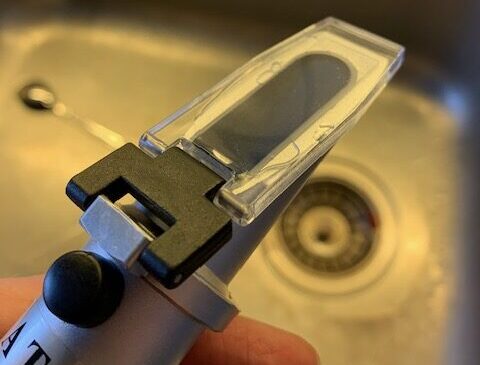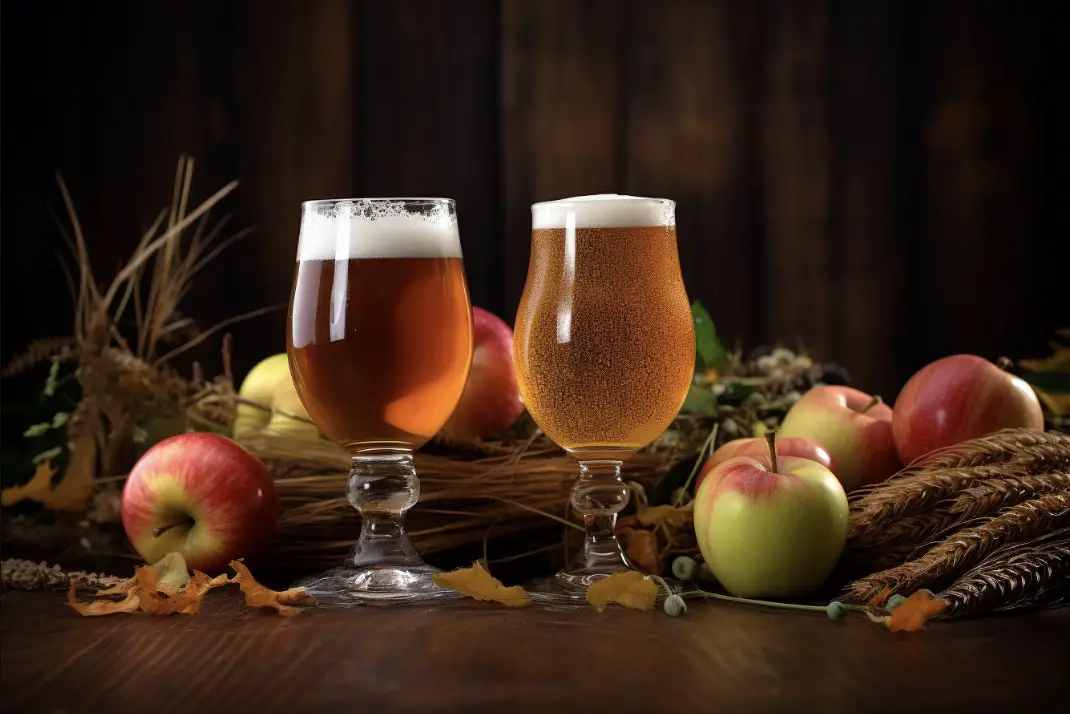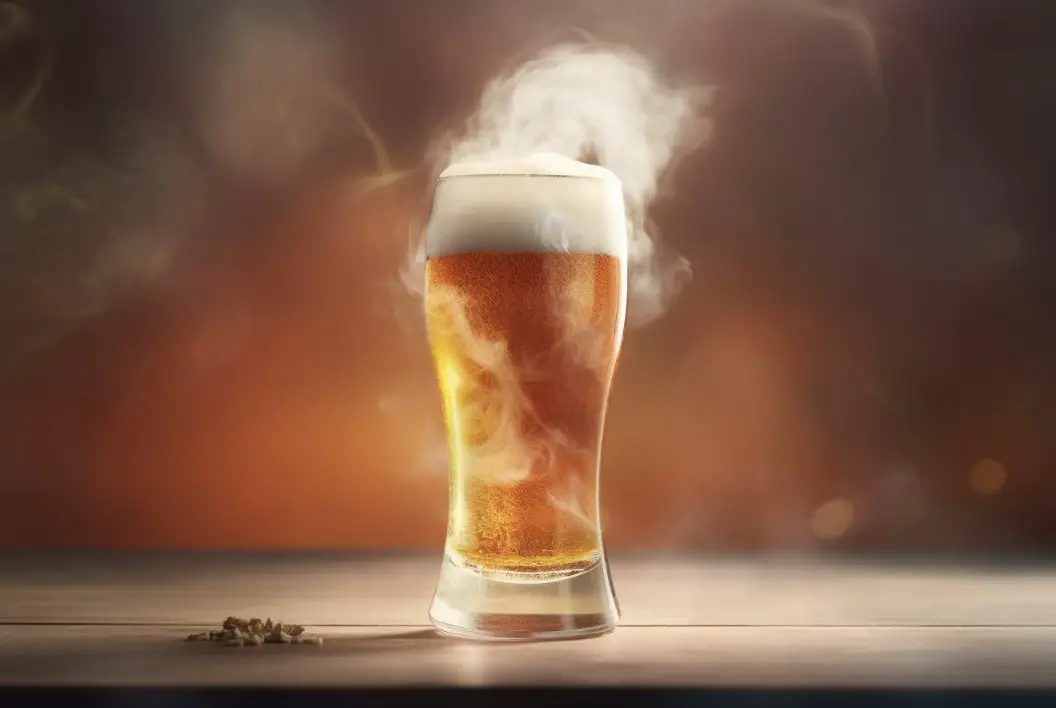Refractometers are an essential tool for every cider maker, enabling them to precisely measure the sugar content of their brew. This guide provides useful information about using a refractometer in cider making.
| Description | |
| What is a Refractometer? | A device used to measure sugar content of liquid sample |
| How does it work? | The device uses refraction to measure the degree of bending of light passing through the sample. |
| Benefits of using a Refractometer in Cider Making | Provides accurate and quick sugar measurements, no need for hydrometer or other equipment, and helps avoid incorrect readings due to temperature variations. |
Moreover, some types of refractometers can also be used to monitor alcohol levels during fermentation.
And contrary to a hydrometer, a few drops of the sample are all that is needed for reliable testing.
Pro Tip: Always calibrate your refractometer before use and clean it after each measurement.
Before you go cider crazy, you better understand the science behind a refractometer or you might end up with apple juice instead of hard cider.
Understanding The Refractometer
To understand how to use a refractometer for cider making, you need to first understand the instrument and its purpose. What is a refractometer?
How does a refractometer work? You may wonder. In this section, you will get the answers to these questions. Furthermore, we will also discuss the benefits of using a refractometer for cider making.
What is a Refractometer?
Refractometers are precision instruments utilized to measure the refractive index of materials. This index is a dimensionless number that demonstrates how light waves bend while travelling through a material.
Direct Light Refractometer

Simple and easy to use
Super affordable, sturdy refractometer that also shows SG-equivalent.
- Classic monocular design
- Dual scale (Brix and Specific Gravity)
- Comes with a practical storage case
- Very reasonable priced
Utilizing this information, refractometers can calculate the concentration of dissolved substances in liquids and gases, such as sugar levels in apple or grape juice but also e.g. protein content in milk.
The following table provides information about what can be measured with refractometers and some examples of use:
| What Can be Measured | Measuring Range | Examples of Use |
|---|---|---|
| Liquid Sample Refraction | 1.3300 ~ 1.5300 | Honey, Beer, Fruits etc |
| Salinity Concentration | 0 ~ 100ppt | Seawater, Brine, Soil etc |
| Plasma Protein Concentration | 0~12g/dl | Medical diagnosis for liver/kidney diseases |
It is noteworthy that refractometers have additional applications in numerous industries like automotive coolant quality checking, gemstone identification and even in veterinary medicine.
Pro Tip – While using refractometers for measuring samples of high viscosity or those containing suspended particles or bubbles; wait until they settle before testing to prevent inaccurate readings.
Prepare to get schooled on how a refractometer turns your liquid into a mathematical equation.
How Does a Refractometer Work?
A refractometer is an essential instrument in various fields like food, science, and agriculture. It determines the amount of light that bends as it passes through a substance. By measuring the angle of refraction, it gives us a reading called a refractive index.
| Refractometer | Works based on | Measures |
|---|---|---|
| Gemstone Refractometer | Lights’ bending ability | Gemstones refractive index |
| Digital Refractometer | Lights’ bending angle | Sugar content in liquids or solutions. |
| Brix Refractometer | Lights’ bending angle | Total sugar content in juices and fruit-based products. |
Apart from gemstones and sugar-related measurements, a few other specialized types of refractometers also give us readings for liquids like coolant strength or salt levels.
Pro Tip: Always calibrate the device to get accurate results.
Not only does a refractometer help you make better cider, it also makes you feel like a mad scientist in the process.
Benefits of using a Refractometer for Cider Making
Using a Refractometer can enhance Cider Making. The device measures the exact amount of sugar present in the mixture, ensuring a high-quality end product. It also saves time and guesswork.
Benefits of using a Refractometer for Cider Making
Here are the benefits of using a Refractometer:
| Benefit | Details |
|---|---|
| Saves time | Provides quick and convenient results |
| Accurate measurements | Measures the exact amount of sugar present |
| Reduces Guesswork | Ensures precision by reducing human error |
| Easy to use | Simple and fast to understand |
Furthermore, Refractometers have multiple uses such as measuring the sugar content in fruits, honey, and beverages. These devices are practical tools for amateur and professional cider makers alike.
In addition to producing consistent cider quality, refractometers offer an advantage in detecting fermentation issues before they progress too far.
Do not hesitate to purchase this gadget to indulge in precise Cider Making techniques.
If you’re planning on making some cider, just remember: using a refractometer is like having your own personal truth serum for apples.
How to Use a Refractometer for Cider Making
To make sure you have an accurate measurement of your cider’s sugar content, it’s essential to know how to use a refractometer.
Preparing the Refractometer
To set up the refractometer for measuring cider’s sugar content, we must ensure its accuracy and cleanliness.
- Optimizing and Preparing the Refractometer:
- Clean the refractometer prism with distilled water or ethanol wipes to avoid any residue that may impact readings.
- Calibrate the refractometer with distilled water or calibration solution according to manufacturer instructions or use automatic temperature compensation (ATC).
- Ensure that the sample size is sufficient to cover the prism but not too much that it seeps into the hinges of the instrument.
It’s essential to note that calibration should be done before every session, and storage in a dry place prevents dust build-up on optics.
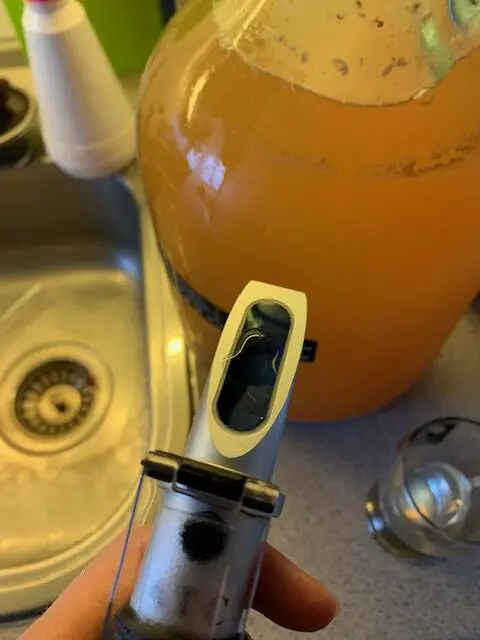
Lastly, make sure you follow these steps as an inaccurate reading can lead to incorrect ingredients leading to spoilt batches of cider.
Don’t worry, the only thing you’ll be stealing is a tiny sip of cider when taking a sample with your refractometer.
Taking a Sample
To Obtain a Cider Sample for Refractometer Reading:
- Sterilize the tools needed such as a sanitized hydrometer, beaker and thief.
- Take a sample of cider from underneath the surface of the vessel to avoid collecting too much yeast or sediment.
- Draw in one fluid motion to eliminate air bubbles in the cider.
It is important to ensure that the hydrometer used is sanitized before use, as any contaminants could alter the reading causing an inaccurate result.
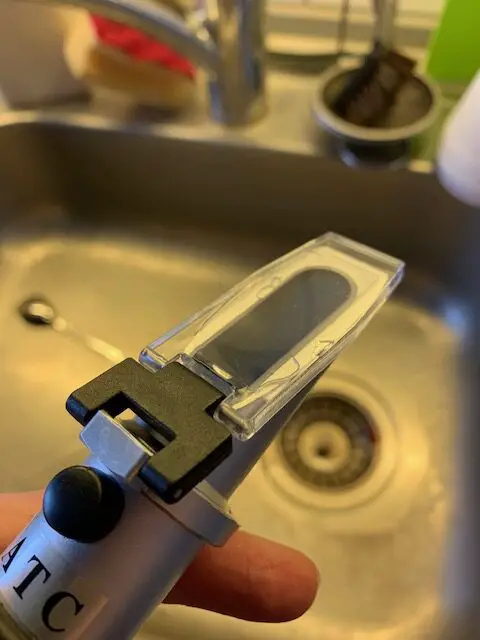
According to ‘The Joy of Home Brewing’ by Charlie Papazian, taking an accurate sample is crucial in determining correct sugar content and fermentation process success.
Want to know the sweet truth about your cider? Measure its Brix level with a refractometer and never be in the dark again.
Measuring the Cider’s Brix Level
To determine the brix level of your cider, you need to measure its sugar content. This is critical in ensuring that your cider has the right balance of alcohol and sweetness.
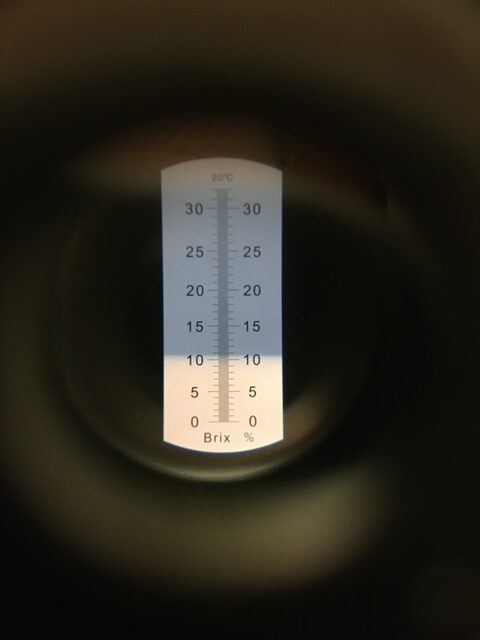
To measure the brix level accurately, you’ll need a refractometer. Take a few drops of cider and place them onto the surface of the refractometer prism. Then, close the cover and look through the eyepiece to get a reading.
The table below shows the typical brix levels for various stages in making cider:
| Stage | Brix Level |
|---|---|
| Apple Juice | 10-15 |
| Fermenting Cider | 6-8 |
| Ready-to-Bottle Cider | 0-2 |
It’s important to note that different types of apples can produce different sugar levels, leading to variations in brix measurement.
When measuring your cider’s brix level, make sure it’s at room temperature as this can affect readings. Also, clean and dry your refractometer before use.
Interestingly, refractometers were first used by winemakers to test grape ripeness and sugar content in soil samples during the 19th century.
Overall, measuring your cider’s brix level is an effective way to ensure you’re on track with fermentation and producing a delicious brew. Get ready to geek out on the science of cider with the interpretation of your refractometer results!
Interpretation of the Results
After measuring the sugar content of your cider using a refractometer, understanding the results is crucial for determining its progress in fermentation. Analyzing the data obtained from a brix scale allows you to measure the degree of sweetness or dryness of your cider.
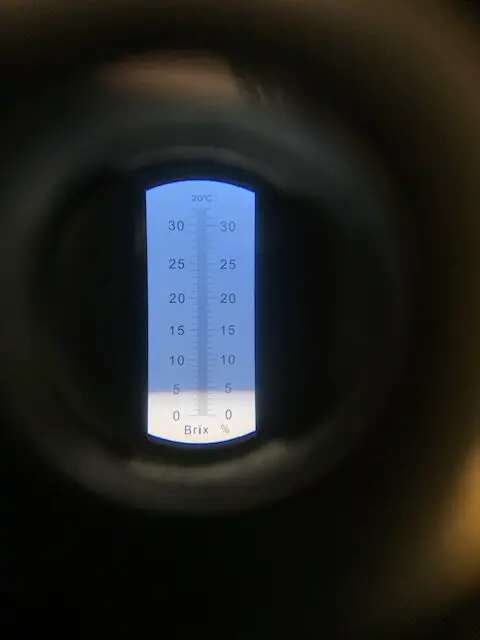
The following table presents an example of how to interpret your refractometer readings and what they mean for your cider-making process. The table includes Brix measurements at different stages of fermentation, along with corresponding potential alcohol levels and descriptions of the specific phase.
| Brix Reading | Potential Alcohol Level | Stage Description |
|---|---|---|
| 5 | 0% | Sweet Cider |
| 10 | 1% | Early Fermentation |
| 15 | 2% | Mid-Fermentation |
| 20 | 3% | Late Fermentation |
| 26+ | >3% | Expected Final ABV |
It is essential to note that obtaining precise and consistent measurements throughout the cider-making process will yield more accurate results. As a pro-tip, collecting samples at various stages during fermentation and recording their brix readings can help identify trends and optimize future batches. With a refractometer, you’ll never have to guess if your cider is alcoholic or just apple juice with a kick.
Benefits of Using a Refractometer for Cider Making
To get the most out of your cider making, it’s crucial to understand the benefits of using a refractometer. This essential tool offers many advantages, such as saving you time and money, producing better quality cider, and providing more accurate readings. With this understanding, you can make informed decisions about your cider making and ensure a successful outcome every time.
Saving Time and Money
Using a Refractometer for Cider Making can lead to numerous benefits, including significant savings in both time and money. With the advanced technology of the refractometer, cider makers can quickly measure the sugar content of their juice samples without relying on guesswork, resulting in more efficient production processes and reduced costs.
- Cider makers can save time by not needing to send juice samples to external laboratories for analysis.
- The speed of measuring sugar content with a refractometer allows faster adjustments to be made during the fermentation process.
- Improved accuracy in sugar measurements leads to higher-quality cider production, reducing waste and increasing profits.
- Inaccurate measurements resulting from traditional methods can lead to spoilage or unexpected changes in flavor, affecting product quality and profitability.
Even with traditional lab testing methods, it is not always possible to maintain consistent quality due to variations in fruit growth conditions and harvest timing. However, using a refractometer can help overcome these challenges by providing precise measurements that allow for greater predictability and control over the final product.
Making cider is not just a hobby but also an art form appreciated by many consumers. By utilizing modern tools such as Refractometers, enthusiasts can remain competitive with large-scale commercial producers. So don’t miss out on the benefits of using Refractometers for Cider Making – invest today!
Who needs friends when you have a refractometer to guarantee a high-quality and delicious cider every time?
Better Quality Cider
Refractometers: Enhancing Cider Excellence
Refractometers have become a vital tool in the cider making process, raising the bar of cider quality to greater heights. Here are five ways refractometers improve cider excellence:
- Accuracy: Refractometers measure sugar levels with precision, resulting in consistent and uniform cider.
- Efficiency: These instruments reduce time associated with manual hydrometer readings.
- Adaptability: Refractometers can be used at different stages of the fermentation process, from apple pressing to bottling.
- Flexibility: They work seamlessly on site or in any laboratory setting.
- Affordability: Refractometers provide accurate readings at a lower cost compared to other testing methods.
Additionally, refractometers can also detect sour or spoiled apples, ensuring the retention of high-quality output. Such qualities make them a beneficial investment for both small and large scale commercial cider makers.
It is worth noting that refractometer technology has come a long way since its discovery by Ernst Abbe in 1869 during his work on microscope lenses. It wasn’t until several years later that their use extended beyond measuring sugar concentrations in the beverage industry.
Today, they have been adapted into various fields such as food processing and wine production, revolutionizing quality control procedures across industries. Refractometers remain indispensable tools that optimize productivity while improving product quality. If you’re messing around with cider making, you don’t want to cry over spilt juice – get yourself a refractometer for more accurate readings.
More Accurate Readings
The use of a refractometer in cider making can provide more precise and exact readings than other tools. This allows for better quality control during production and fermentation, leading to consistent and well-balanced flavors in the finished product.
By measuring the specific gravity of the cider with a refractometer, the sugar content can be accurately determined throughout the brewing process. This allows for more informed decisions regarding when to add additional ingredients or adjust fermentation times. The refractometer also provides instant readings, eliminating waiting times that come with using other methods.
In addition to accuracy, the refractometer is an easy-to-use tool that does not require much experience or training to operate. With regular use, brewers will find that they are able to fine-tune their techniques and continuously improve their product.
Brewers who want to take it a step further in terms of accuracy may consider calibrating their refractometer regularly. It is also important to keep it clean and properly stored between uses to ensure accurate readings each time.
In summary, using a refractometer in cider making offers many benefits such as precision, consistency, efficiency and ease of usage. With this tool at hand, brewers can achieve excellent results every time with minimal effort required.
Using a refractometer for cider making is like having X-ray vision for apple juice – you’ll see everything and know exactly when it’s ready to drink.
Tips for Using a Refractometer for Cider Making
To master the art of measuring the sugar content of your cider with a refractometer, you need to keep in mind a few tips. Proper calibration, temperature correction, cleaning and maintenance can all impact the accuracy of your readings. In this section on “Tips for Using a Refractometer for Cider Making,” we’ll guide you through each of these sub-sections to ensure your refractometer is working at its best.
Calibration
To Achieve Accuracy of Cider Consistencies
Creating precise and consistent cider requires the proper use of a refractometer. One essential aspect for ensuring this precision is through proper calibration. Calibration may sound tedious, but it is necessary to ensure accurate readings.
Table with True and Actual Data
To calibrate your refractometer, follow these steps:
- Place distilled water on the prism
- Read the Brix level (should be 0)
- Clean the prism with a soft cloth
- Read the Brix level again
- Place two drops of cider on the prism
- Take a reading of the Brix level
Unique Details
Remember to clean your refractometer’s prism before taking a reading, as any debris can affect your readings. Additionally, do not touch the prism surface during your testing process.
True Story
A cider brewer once shared that they neglected to calibrate their refractometer before starting a batch of cider. This led to inaccuracies in their final product and ruined an entire batch. Remember always to calibrate for accuracy!
Adjusting the temperature with a refractometer is like giving your cider a warm hug, without the awkwardness.
Temperature Correction
Maintaining Precise Brix Readings with Temperature Adjustment
Accurate measuring of Brix levels is crucial in producing high-quality cider. However, temperature variations can cause inaccurate readings. This problem can be resolved by adjusting the temperature to obtain precise measurements.
To adjust for temperature, use a refractometer with automatic temperature compensation or convert your readings using tables that adjust for temperature. A conversion table involves data that accounts for differences in specific gravity at different temperatures. For example, if the actual reading is 10 °Brix and the temperature is 20°C, then the true reading at 15°C will be 9.8 °Brix.
Below is an example of a Temperature Correction Table:
| Temperature (°C) | – | 5 | 10 | 15 | 20 |
|---|---|---|---|---|---|
| Brix at Temp (°C) | – | 10.0 | 9.9 | 9.8 | 9.7 |
| True Brix | – | 10.1 | 10.2 | 10.3 | 10.4 |
It’s important to note that there may be unique factors affecting your readings such as fermentation rates or sulfite usage, so it’s best to consult with a professional cider maker or expert if you’re unsure about adjusting for temperature.
According to Cider Making Magazine, “Using a refractometer is an essential tool for any home cider maker wanting to produce consistent and high-quality ciders.”
Remember, cleaning your refractometer is like wiping away your sins…except this time, you don’t need to go to confession.
Cleaning and Maintenance
Keeping your refractometer clean and well-maintained is critical to ensuring accurate cider measurements. Here’s what you need to know about keeping your equipment in top condition.
Wipe down the surface of your refractometer with a soft, clean cloth after each use. If there is residue or debris present on the surface, use a small amount of water to dampen the cloth for a more thorough cleaning.
After cleaning, take a careful look at the prism’s surface to ensure that there are no traces of residual juice or other contaminants present. Use an inverted cotton swab to remove any stuck-on debris.
The internal components of your refractometer must remain free from dust and grime. Regularly maintain them by using a special prism solution combined with a chamois or microfiber cloth.
Avoid exposing your refractometer to extreme temperatures or direct sunlight. Also, keep it upright when not in use and store in an enclosed space where it will not be disturbed or damaged.
To guarantee consistent cider measurements, you should calibrate your refractometer regularly(Monthly). Reference samples(Standard solution) can be used for calibration because they contain known concentrations of sugar levels.
The internal optical component may experience wear over time that cannot be corrected by regular cleaning. Get professional service every year(optional)to make sure everything is running smoothly.
- Start with proper cleaning:
- Check for residual juice:
- Maintain the lens and prism:
- Store in a safe place:
- Regular calibration:
- Periodic servicing:
Remember that every cider maker has unique requirements when it comes to their business needs. Aside from the steps above that are common to all users, make sure you pay attention according to your needs.
A cider maker we know once had a problem with inaccurate readings and tried to troubleshoot it. After discovering that the prism was dirty, he cleaned it but still did not see any difference in his measurements. He found out later that the instrument needed to be recalibrated and without delay, arranged for professional service.
Using a refractometer for cider making may not give you perfect cider, but it will definitely give you a perfect way to measure your disappointment.
Conclusion and Final Thoughts
Using a Refractometer for Cider Making: Tips and Tricks
When using a refractometer for cider making, there are a few things to keep in mind to ensure accurate readings. Make sure the calibration is correct before beginning, and take multiple readings to get an average. Also, remember that temperature can affect readings, so keep both the sample and the refractometer at the same temperature. Overall, using a refractometer can simplify the cider making process and provide more precise measurements.
How to Choose the Right Refractometer for Cider Making
It’s important to choose the right refractometer for your needs when making cider. Look for one with a specific gravity range of 1.000-1.130 to accurately measure sugar content in juice. Additionally, opt for a model with automatic temperature compensation (ATC) or manually compensate for temperature differences.
Tips for Accurate Refractometer Readings in Cider Making
To obtain accurate readings with your refractometer when making cider, make sure your cider has reached room temperature before testing. Don’t forget to wipe down the prism between tests as residual traces of liquid can interfere with subsequent readings. Finally, use distilled water to calibrate your device regularly.
How to Care for Your Refractometer When Making Cider
Caring for your refractometer is crucial in maintaining its accuracy over time. Keep it away from direct sunlight and moisture and store it in a protective case when not in use. Regularly clean the prism lens with microfiber cloth or cleaning solution designed specifically for optical lenses.
Frequently Asked Questions
1. What is a refractometer and why do I need it for cider making?
A refractometer is a tool that measures the sugar content of liquid, which is essential for cider making as the sugar levels directly impact the alcohol content and flavor of the final product.
2. How do I use a refractometer for cider making?
You simply need to extract a small sample of cider from your batch, place it onto the refractometer’s prism, and then look through the eyepiece to read the sugar level measurement.
3. Can I use a refractometer to determine the alcohol content of my cider?
Some refractometers measure the alcohol content of a liquid given there is not residual sugar, however these are not very precise with complex mixtures such as cider, beer or wine (better for liquors and distillates). However, you can use a hydrometer to measure the specific gravity of your cider before and after fermentation to determine the alcohol content.
4. Is there a specific refractometer I need to use for cider making?
Any refractometer that measures in Brix (the sugar content measurement unit) can be used for cider making.
5. Are there any common mistakes to avoid when using a refractometer for cider making?
One common mistake is not properly calibrating the refractometer, which can lead to inaccurate readings. It’s important to calibrate the tool with distilled water before use. Additionally, make sure the sample is mixed well before measuring for consistent results.
6. Can I use a refractometer to determine when my cider is ready for bottling?
While monitoring sugar levels is important during the fermentation process, a refractometer cannot determine when it’s ready for bottling. You’ll need to rely on other indicators such as taste and aroma to determine when your cider is ready for bottling.

